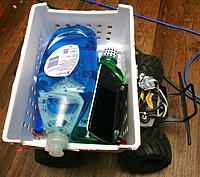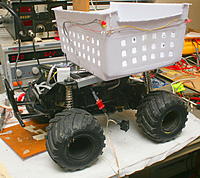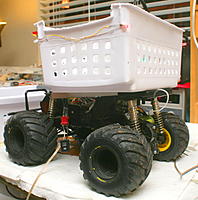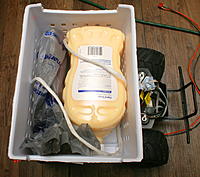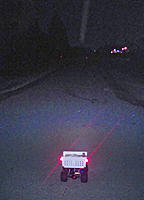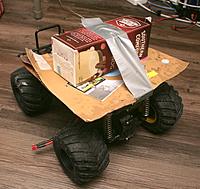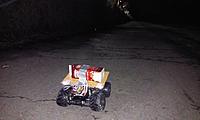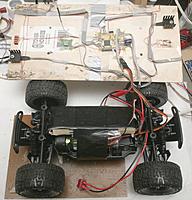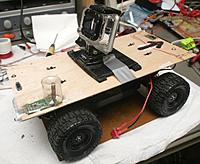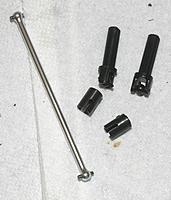Archive for December, 2015
Comments (0)
Add Comment
-
 Views: 164
Views: 164
Headlights rearranged to withstand collisions. It really needs a bumper. -
 Views: 165
Views: 165
To make it fit a shaft too small, make the hole even bigger. -
 Views: 197
Views: 197
The secret use of hot glue to make Dean connectors easier to pull apart. -
 Views: 150
Views: 150
The last of the original remote control. It lasted 2 years. -
 Views: 171
Views: 171
Heavily rusted. -
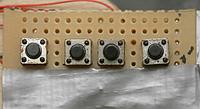 Views: 167
Views: 167
2nd set of buttons rusted. -
 Views: 146
Views: 146
New buttons. -
 Views: 164
Views: 164
Completed remotes for 2 vehicles.
-
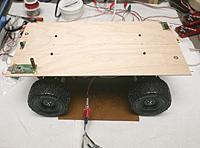 Views: 158
Views: 158
A 1st stab at the hardware was complete. The entire top surface was available for a very light camera. -
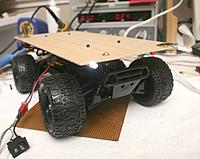 Views: 149
Views: 149
Once again, a mechanical headlight switch was favored over a wireless MOSFET. -
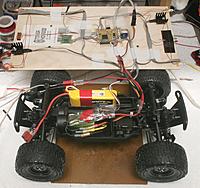 Views: 169
Views: 169
The old 3S 1Ah fits nicely, but can be slightly bigger. Tried a fabric tape, which ended up not holding as well as the old paper tape. -
 Views: 146
Views: 146
Comparison of battery technology. -
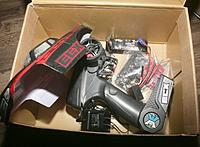 Views: 150
Views: 150
Nothing enters the apartment without shedding most of its parts.
-
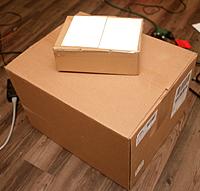 Views: 155
Views: 155
The vehicle arrived. -
 Views: 162
Views: 162
-
 Views: 170
Views: 170
Final shots of the original product. -
 Views: 172
Views: 172
Final view of the original electronics. -
 Views: 172
Views: 172
Didn't bother at all with the included brushed motor. Tacon motors have been doing well, so went with a Tacon 2040-2900kv. -
 Views: 154
Views: 154
The holes weren't in a circle, a real trap for old players. Fortunately, 1 pair of holes matched the Ruckus, but the shaft was too small. The pinion required heatshrink to stay on the shaft. -
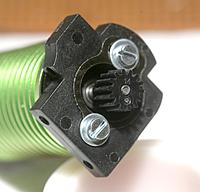 Views: 167
Views: 167
It required 2.5mm bolts, not included with the motor & not previously used on the brushed motor. Fortunately, OSH opened a new store which was still fully stocked with every metric bolt. -
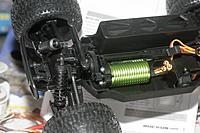 Views: 170
Views: 170
Accessing the gearbox required 7 rare screws, stripping a few. There was no way to adjust the gear distance, in the end just mashing them together as tight as possible.
-
 Views: 155
Views: 155
2 automotive computers, retaining the old one for a future 2nd vehicle. The new computer is indeed lacking the filter capacitor. -
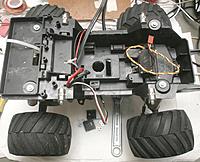 Views: 165
Views: 165
Removed the old computer & ground away more of the plastic inserts. Disappointing how much spaces is taken by plastic inserts. It could have been designed as an empty bathtub. -
 Views: 159
Views: 159
New board installed -
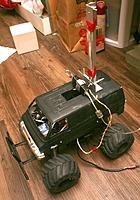 Views: 165
Views: 165
The modern technique is to have the mag on a mast, but the mag on the mast is slightly off. Purpose built quadcopters have their mast aligned perfectly.


